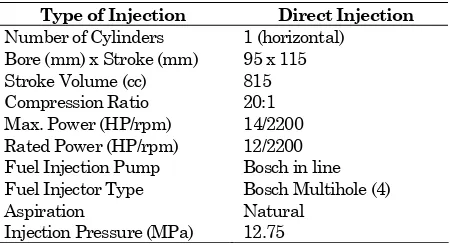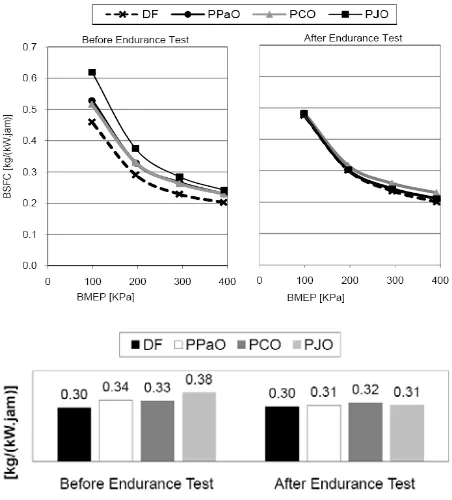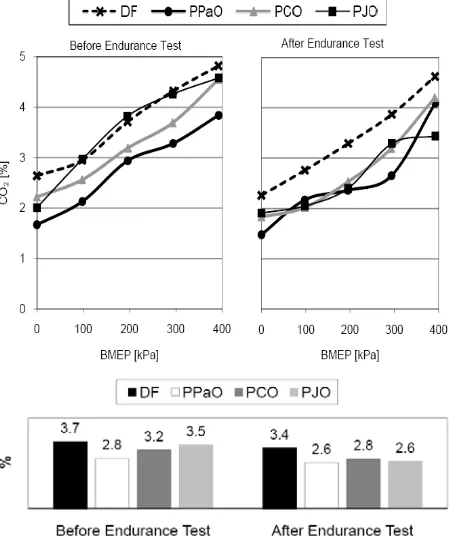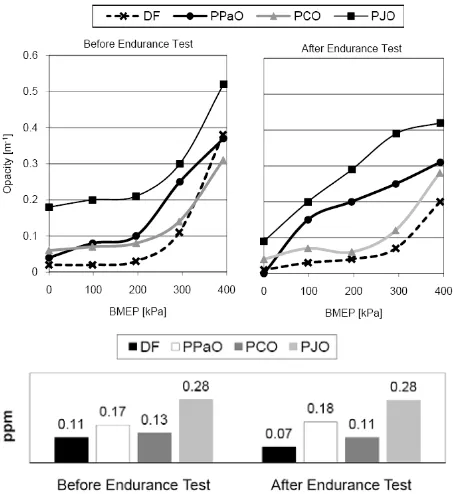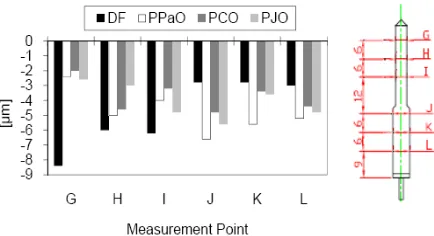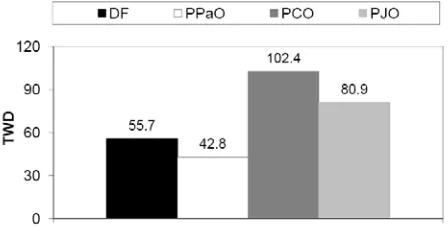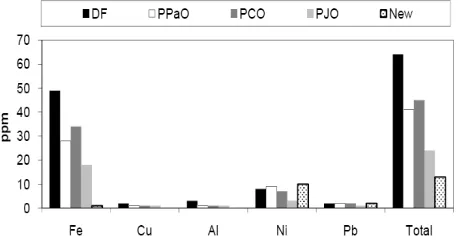Iman K. Reksowardojo, Y. Hartanto, T. P. Brodjonegoro, W. Arismunandar Faculty of Mechanical and Aerospace Engineering, ITB, Bandung
Email: [email protected], [email protected]
ABSTRACT
Diesel engine can be operated on either pure plant oil (PPO) oil or biodiesel. Biodiesel production process is expensive due to many stages of processes, while PPO has a lower cost of production, lower energy consumption, and simpler process. There are several potential biofuel resources in Indonesia such as coconut, palm, and jatropha. They are tropical plants with large amonts of their quantity. Experiment was conducted in 17 hours engine running test (endurance test) with various operating cycle conditions. Test fuels are pure coconut oil (PCO), pure palm oil (PPaO), pure jatropha oil (PJO), and diesel fuel (DF) as a datum. Each PPO blends with diesel fuel with composition 50%-volume. As a result, PCO has higher BSFC (10%) before endurance test in comparison with diesel fuel, also PPaO (13%) and PJO (27%) show a similar condition. Surprisingly, all PPO have BSFC almost similar with DF after endurance test due to decreasing of engine components friction. On the other hand, PPO produces more uncompleted combustion than DF. Phosporus content has major responsibility of deposit growth. PCO, PPaO, and PJO result more engine deposits in comparison with DF, which accounts for 139,7%, 232,9%, and 288,9% respectively. Based on wear analysis, PCO has the best antiwear property among test fuels, whereas the worst is DF.
Keywords: pure plant oil, biofuel, coconut oil, palm oil, jatropha oil
INTRODUCTION
Vegetable oil can be used on diesel engine directly (crude oil and pure plant oil) or by conversion to fatty acid methyl ester (known as biodiesel). Crude oil and pure plant oil still have a high viscosity while biodiesel have a low viscosity. Pure Plant Oil (PPO) is crude oil which its free fatty acid and phosphorus have been removed. Biodiesel is a fatty acid which its glycerol chain have been removed thus its viscosity similar to diesel fuel (DF).
In biodiesel production, various processes is required which increase production cost. PPO is vegetable oil, it need less process and less expensive. There are several potential biofuel resources in Indonesia: coconut, palm, and jatropha. They are tropical plants with large amounts of quantity.
In the previous study in JSAE Review 22, it was reported that diesel engine can be operated successfully using coconut oil [1], palm oil [2], and jatropha oil [3]. In present study, those fuels are compared by engine performance, emission, their effect on engine compo-nent. These experiments are done with fuel tank heater.
RESEARCH METHODOLOGY
Test Engine and Operating Condition
These experiments were conducted on an 815cc single cylinder engine. The engine specification is
shown in Table (1). Engine was installed with ribbon heater as fuel heater which is convoluted in fuel filter. Engine was connected to a 5kW, 220V, 50Hz electric generator that supply to series water heater to vary engine loads. Stargas 898 was utilized for exhaust gas emissions measurements. Smoke was measured with Technotest Smokemeter 495/01.
Table 1. Test Engine Specifications
Type of Injection Direct Injection Number of Cylinders 1 (horizontal)
Bore (mm) x Stroke (mm) 95 x 115 Stroke Volume (cc) 815 Compression Ratio 20:1 Max. Power (HP/rpm) 14/2200 Rated Power (HP/rpm) 12/2200 Fuel Injection Pump Bosch in line Fuel Injector Type Bosch Multihole (4)
Aspiration Natural Injection Pressure (MPa) 12.75
Table 2. Operating Conditions
Speed (rpm) Load (watt) Duration (min)
1000 0 15
1500 4000 10
2000 4000 5
on diesel engine one cylinder with zero loads, 45% load, and 65% load of maximum load. The operating conditions is shown in table 2 which repeated 34 times (total 17 hours endurance test). In PPO experiment, fuel was heated and constantly maintained at 65oC to lower its viscosity which will
increasde its spray quality.
All components of engine, which possible influenced by the fuel before combustion process (plunger and injector nozzle) and after combustion process (piston and piston rings), were changed with new parts. Break-in process is done one hour with new piston and piston rings before the test were started.. The engine performances and exhaust gas emissions were measured after break-in for “before endurance test” data and after finishing 17 hours test for “after endurance test” data.
Another test fuel properties are distillation temperature (as shown in figure 1). It shows that PPO has higher volatility than DF which indicate PPO has poor spray characteristic (bigger droplets).
Figure 1 Distillation Curve for Test Fuel
Possibility of clogging occurs in injector when engine was stopped and causes difficulties for next engine start up. This is caused by solidification of PPO on injector holes. To avoid this condition, flushing was done by running the engine using diesel fuel at 1500 rpm with idle condition for 30 minutes. Flushing was done after performances and emissions measurements.
Data was taken at 1500 rpm with following loads: idle, 1kW, 2kW, 3kW, and 4kW. Dimensions, weight, and photograph were collected before and after test. Deposit thickness in piston and cylinder head were measured with Mitutoyo Thickness meter. Deposit content in piston is also investigated using CRC Manual No. 18 method [5].
Test Fuel
Diesel fuel, blend with 50% palm oil (PPaO), blend with 50% coconut oil (PCO) and blend with 50% jatropha oil (PJO) were tested in this experiment. PCO and PPaO were refined, bleached, deodorized while Jatropha oil was degummed and neutralized before used. The test was done using fuel heater because PPO viscosity still three times higher than that of diesel fuel even though blended with diesel fuel.
RESULT AND DISCUSSION
Engine Performance and Emissions
Figure 2. BSFC at 1500 rpm
Table 3 Properties of Test Fuels
Properties DF 50% PCO 50% PPaO 50% PJO 100% PCO 100% PPaO 100% PJO
Conradson Carbon Residue on 10%
distillate residue (%wt) 0,12 - - 3 - 5,59 14,03
Sulphur Content (ppm) 0,253 0,125 0,121 0,135 0,018 0,012 0,009
Phosphor Content (ppm) 10 - * - * - * 1 14 19
Magnitude and trend of engine performance using four types of fuel after endurance test are quite different from that of before endurance test. Figure (2) shows the using of PJO gives the highest BSFC among other PPO before the endurance test eventhough its lower energy content is not the lowest. After endurance test, all PPO BSFC decreased with the largest reduction is of PJO, followed by PPaO and PCO. This degradation happen not because a better combustion but less friction loss occurred as shown in components diameter reduction.
Figure 3. Thermal Efficiency at 1500 rpm
Figure 4. Oxygen Emissions at 1500 rpm
Thermal efficiency is inversion of BSFC. Thermal efficiency of four types of fuel are slightly different between before and after endurance test, as shown in figure (3). Interesting phenomenon in this test is a high thermal efficiency of PPO compared to diesel fuel though PPO BSFC is higher than diesel fuel.
Figure 5. Carbon Dioxide Emissions at 1500 rpm
Figure 7. Unburned Hydrocarbon Emissions at 1500 rpm
Figure 8. Opacity Emissions at 1500 rpm
Perfect combustion produces lower both carbon monoxide and oxygen and higher carbon dioxide emissions. As in Figure (4), (5), (6), and (7) it can be concluded that PPO produces more incomplete combustion. Oxygen content in PPO gives higher result than diesel fuel but it does not indicate that diesel fuel combustion more perfect than PPO because oxygen content can be obtain from PPO itself.
PPO unburned hydrocarbon is higher than diesel fuel. This phenomenon is caused by poor atomization of PPO and consequently poor fuel vaporization and combustion. Larger spray penetration of PPO resulting in flame quenching in cylinder wall much more than diesel fuel. Diesel fuel unburned hydrocarbon increasing after endurance test while PPO unburned hydrocarbon is relatively stable.
From Figure (8), PPO opacity is higher than diesel fuel where PJO gives the highest opacity because of its poor combustion and higher phospor level content. Phospor level in fuel will increase particulat in emission and deposit formation. PCO give lowest opacity among PPO but still higher than diesel fuel though its phospor level is the lowest among all fuel. It is caused by poor combustion and UHC (unburned hydrocarbon) detected as opacity.
Effect on Engine Component
Engine components which is investigated are in-line bosch pump (plunger and its barrel), injector (nozzle and nozzle needle), piston, and cylinder head. Those components condition were influenced by properties of fuel.
Plunger
Plunger is component in-line bosch pump that control fuel rate and increase fuel pressure. Its analogy with piston and cylinder liner work, plunger is piston and plunger barrel is cylinder liner. So, there is a surface contact between plunger and its barrel. Lubrication in this system is using the fuel. Change of diameter of plunger indicates lubrication properties of fuel. From this experiment, diesel fuel gives the highest reduction of diameter. It indicates diesel fuel has worse lubrication properties than PPO. Among PPO itself, PCO have the lowest reduction of plunger followed by PPaO and PJO. Characteristic of compound chain of these three fatty acid influence the lubricant capability. The longer its chain, cohesion on its boundary layer is weaker [6]. So, PCO which has the shortest chain (PCO: C12:0,
PpaO: C16:0; C18:1, and PJO: C18:1; C18:2) gives the
strongest boundary layer bond among others PPO which results better lubrication properties.
Injector
Figure 9. Change of Diameter of Plunger After Test
DF PPaO PCO PJO
Figure 10. Injector Condition After Test Compare to New Condition
Diesel fuel gives the lowest deposit in nozzle. Diesel fuel gives better combustion because it has better fuel atomization. So, diesel fuel results less deposit than other experiment fuel. The largest amount of deposit achieved by PPaO because its viscosity is the largest and volatility is the lowest. PCO has the lowest amount of deposit because of it has low phospor content and its combustion is the most perfect one among other PPO. Figure 10 shows the photograph of injector and change of nozzle tip diameter is given in figure 11.
Figure 11. Change of Diameter of Nozzle After Test
Similar to plunger, reduction diameter of nozzle needle indicates lubrication properties of fuel. The result is PPO give better lubrication on high clearance area (G,H,I) but opposite trend occurred on small clearance (J,K,L). High viscosity of PPO causes worse flow properties on small clearance area. As the result, PPO give more wear on point J, K, L.
Figure 11. Change of Diameter of Nozzle Needle After Test
Piston
Piston condition is indicator of combustion process that occurs in engine. Deposit content on piston is known by measuring deposit thickness by thickness meter and piston rating using CRC Manual no. 18 method.
Highest deposit on piston occurred on PJO because of its phosporus level content is the highest and it has lots of impurity. PPaO which has the largest viscosity have the lowest deposit in piston among PPO. It prove that deposit formation is more affected by phosporus level in fuel. Diesel fuel deposit is the lowest in this experiment because of its spray characteristic is better than PPO.
DF PCO
PPaO PJO
impingement point
Figure 12. Piston Condition After Test Compare to New Condition
piston groove, and piston land. By CRC method we get the highest TWD and total demerit are produced by PCO.
Figure 13 Average of Deposit Thickness on Piston
Figure 14 Piston Total Weighted Demerit
Figure 15. Piston Total Demerits
Cylinder Head
Deposit in cylinder head has similar tendency with deposit which occurs in piston. It could happen because both cylinder head and piston are components of combustion chamber. Figure 16 shows average deposit thickness on cylinder head and figure 17 show its photographs.
Effect on Engine Oil
Blow-by process always occurs in internal combustion engine. It results is fuel dilution on engine oil. Engine oil is analyzed to know the effect of using PPO on lubrication characteristic.
Viscosity is one of the most important properties of engine oil. Engine oil in PPaO experiment has largest viscosity reduction. Diesel fuel and PPaO viscosity has reach low limit permission. Diesel fuel blowby greatly affect viscosity reduction. PPaO viscosity reduction is caused by blow-by due to high viscosity and low volatility. Lowest decreasing result on PJO because PJO spray did not produce blow-by.
Figure 16. Average of deposit thickness on cylinder head
DF PCO
PPaO PJO
Figure 17. Cylinder Head Condition After Test Compare to New Condition
Figure 18. Engine oil Viscosity After Endurance Test and Its New Condition
Figure 19. Wear Metal Content on Engine Oil After Endurance Test and Its New Condition
CONCLUSION
From this study, it was shown that coconut oil and its blend with diesel fuel gives higher BSFC than diesel fuel and worse emissions because poor atomization due to high viscosity and heating value of coconut oil is lower than diesel fuel.
High viscosity of coconut oil impacts on better fuel system components lubrication. On the other hand, engine oil degradation is greater when operate diesel engine with coconut oil. So, it reduces period of engine oil utilization.
Coconut oil gives less deposit in combustion chamber but more deposit in piston land, piston ring, and piston grooves. It happens because its high penetration due to high viscosity of coconut oil.
REFERENCES
1. Machacon, H. T. C., Matsumoto, Y., Ohkawara, C. et all., The Effect of Coconut Oil and Diesel Fuel Blends on Diesel Engine Performance and
Exhaust Emissions, JSAE Review 22, 349-355,
2001.
2. Kalam, M. A., dan Masjuki, H. H., Emissions and Deposit Characteristic of a Small Diesel Engine
When Operated on Preheated Crude Palm Oil,
Biomass and Bioenergy, 27: 289-297, 2004.
3. Reksowardojo, I. K., Brodjonegoro, T. P.,. Soera-widjaja, T. H., Arismunandar, W., Dung, N. N., Sopheak, R., Ogawa, H., The Study of Combustion of Jatropha Curcas Linn. Oil (Crude; Degummed; Fatty Acid Methyl Ester) as a Fuel on a Direct Injection Diesel Engine.,The 7th Comodia
“International Conference of Modelling and
Diagnostics for Advance Engine System”,
Sapporo, Japan, 28-31 July 2008.
4. Vincent, M. W., Papachristos, M. J., Williams, D., dan Burton, J., Diesel Fuel Detergent Additive
Performance and Assessment, SAE Technical
Paper 942010, 1994.
5. Manual Rating Piston, CRC Diesel Engine Rating
Manual (CRC Manual No. 18), Coordinating
Research Council, Atlanta, 1991.
